Of all the reptiles, crocodilians inspire the greatest awe and terror. Since their ancestors (over 200 million years ago), these monstrous creatures co-existed with and out-lived the dinosaurs.
Over the millennia, crocodilians continued to develop into the semi-aquatic creatures we know today. Of the 23 crocodilian species, two families are significant to us, crocodiles vs alligators, but what are their differences?
Crocodiles and alligators are two families of reptiles that belong to the Crocodylia order. There are many similarities between these families, including physical features. However, Crocodiles tolerate saltwater better, are widespread, have a V-shaped head, and their bottom teeth protrude.
While crocodiles and alligators may seem identical at first glance, there are some diagnostic differences between these crocodilian families.
Below we’ll investigate their various characteristics, distributions, habitats, behaviors, prey items, threats, and conservation issues.

- Crocodile Vs Alligator: Summary Of Differences
- Behavioral Traits Of Crocs And Gators
- Threats And Conservation
- Which Would Win In An Altercation?
- Final Thoughts On The Differences Between Crocodiles And Alligators
Crocodile Vs Alligator: Summary Of Differences
While, at first glance, crocodiles and alligators may look identical, several diagnostic features help us differentiate between these crocodilian families.
The table below examines some of the prominent differences:
| Feature | Crocodile | Alligator |
| Head shape | Crocodiles have an elongated snout giving them a “triangular” shape. | Alligators have a broader, “blunt” snout, giving them more of a “U-shape.” |
| Teeth | The crocodile’s fourth tooth (from the front) on the bottom jaw pokes out when its mouth is closed (most of its teeth protrude). | Alligators lack this protrusion. Their top jaw overlaps, hiding the teeth while their mouths are closed. |
| Bite force | Saltwater crocodile – 3700 psi | American alligator – 2980 psi |
| Distribution | Africa, Asia, Oceania, and the Americas. | North America and Asia |
| Coloration | Crocodiles are usually a lighter olive green to brown color. | Alligators are darker, with a gray-to-black color. |
| Salt gland | Present | Absent |
| Hind legs | Crocodiles have “jagged fringes” on their hind legs. | Alligators lack the fringe. |
| Top speed | Land: Up to 14 mph water: Up to 20 mph | Land: Up to 14 mph Water: Up to 20 mph |
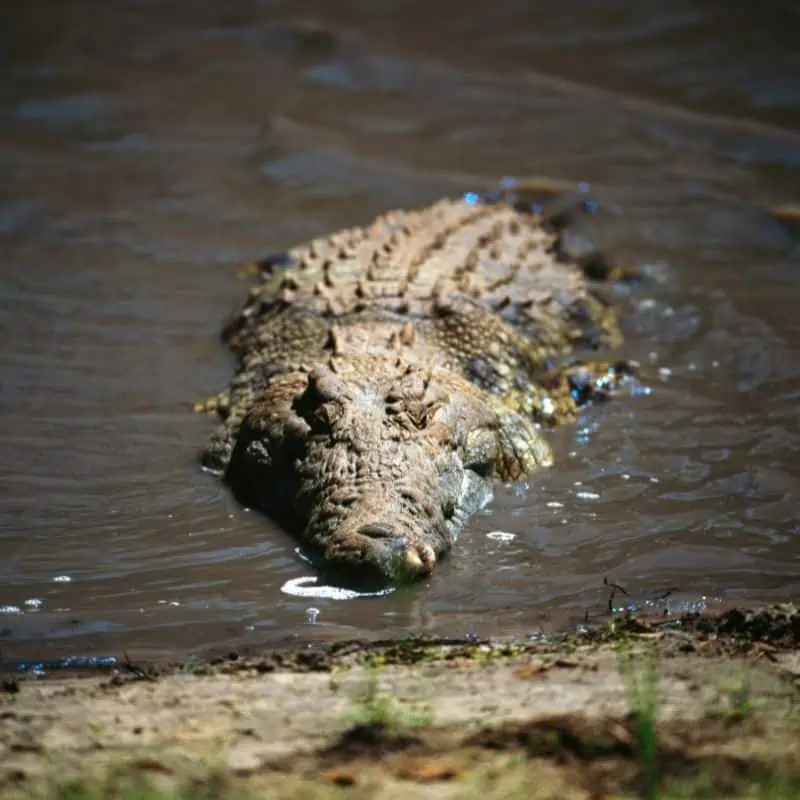
Taxonomical Differences Between Gators And Crocs
Taxonomical studies establish the degree of “relatedness” between various species; by understanding and studying an animal’s taxonomic information, we can find common ancestors, observe where the species separated genetically, and other fascinating information.
The table below compares crocodiles and alligators according to their taxonomy:
| Taxonomy | Crocodile | Alligator |
|---|---|---|
| Kingdom | Animalia | Animalia |
| Phylum | Chordata | Chordata |
| Class | Reptilia | Reptilia |
| Order | Crocodylia | Crocodylia |
| Family | Crocodylidae | Alligatoridae |
| subfamily | Alligatorinae | |
| Genus | Crocodylus, Mecistops, and Osteolaemus | Alligator |
| Species | C. acutus ( American crocodile) | mississippiensis ( American alligator) |
| sinensis (Chinese alligator) | ||
| C. halli (Hall’s New Guinea crocodile) | ||
| C. intermedius (Orinoco crocodile) | ||
| C. johnsoni (Australian Freshwater crocodile) | ||
| C. mindorensis (Philippine crocodile) | ||
| C. moreletii (Morelet’s crocodile) | ||
| C. niloticus (Nile crocodile) | ||
| C. novaeguineae (New Guinea crocodile) | ||
| C. palustris (Mugger crocodile) | ||
| C. porosus (Saltwater crocodile) | ||
| C. rhombifer (Cuban crocodile) | ||
| C. siamensis (Siamese crocodile) | ||
| C. suchus (West African crocodile) | ||
| M. cataphractus (African Slender-snouted crocodile) | ||
| M. leptorhynchus (Central African Slender-snouted crocodile) | ||
| O. osborni (Congo Dwarf crocodile) | ||
| O. tetraspis (African Dwarf crocodile) |
By examining the table, we observe that crocodiles and alligators are in the same order; however, they split at the family level. Crocodiles into “Crocodylidae,” and alligators into “Alligatoridae.”
While there are only two alligator species, there are seventeen crocodile species (several were subspecies).
Crocodiles have a greater genetic diversity than alligators. The alligator family includes caimans (a Central and South American group of crocodilians).
However, they are in a different subfamily, Caimaninae. There are a total of 8 species in the greater alligator family.
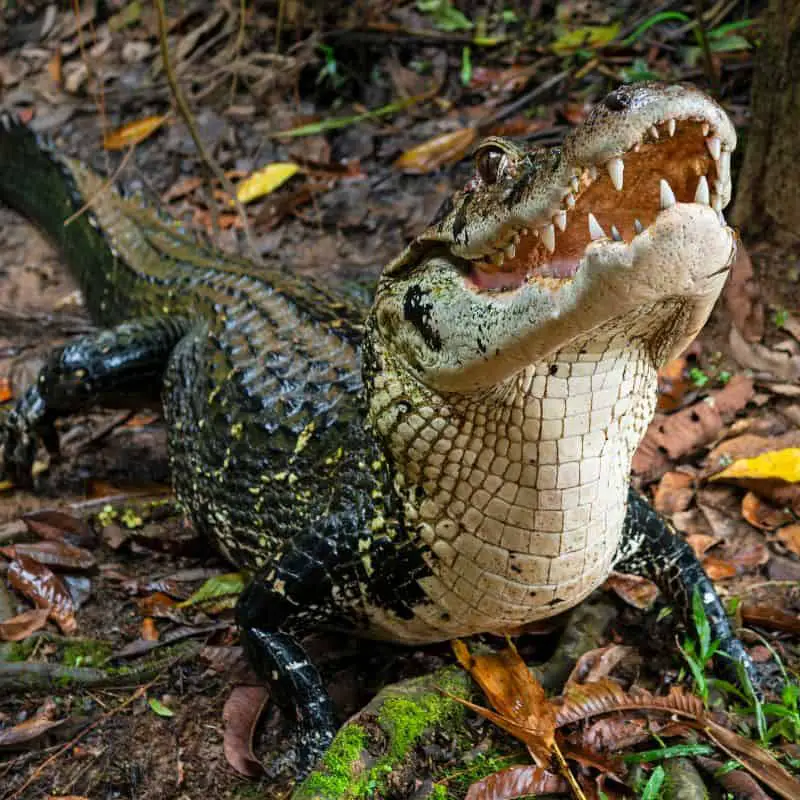
General Characteristics Of Crocodiles And Alligators
Although crocodiles and alligators occupy different families, their shared order means many similarities.
Note: The terms “crocodile” and “alligator” refer to several species, so there are some exceptions to the rules. Exceptional differences are noted as frequently as possible.
Aside from the physical differences between crocodiles and alligators, there are several differences between members of the alligator and crocodile families, respectively.
For example, the Chinese alligator is smaller than its American cousin; however, it has a broader head, and its snout is slightly upturned. Bony plates on the Chinese alligator’s eyelids and belly (called osteoderms) are absent from the American species.
Crocodiles vary dramatically in size and weight, and the shape and length of their snouts also vary between species.
Maximum Age Of Crocodiles And Alligators
Alligators and crocodiles are long-lived species with little difference in their average age limits. Crocodiles generally tend to live longer.
American and Chinese alligators live up to around 70 years in captivity. However, most only make it between 30 and 50 years (in the wild).
Although crocodiles also usually live for roughly 50 to 75 years (in the wild), several specimens made it to 100-plus years (in captivity). The oldest captive crocodile on record (Mr. Freshie) lived 140 years.
Some crocodile species only reach 25 years old.
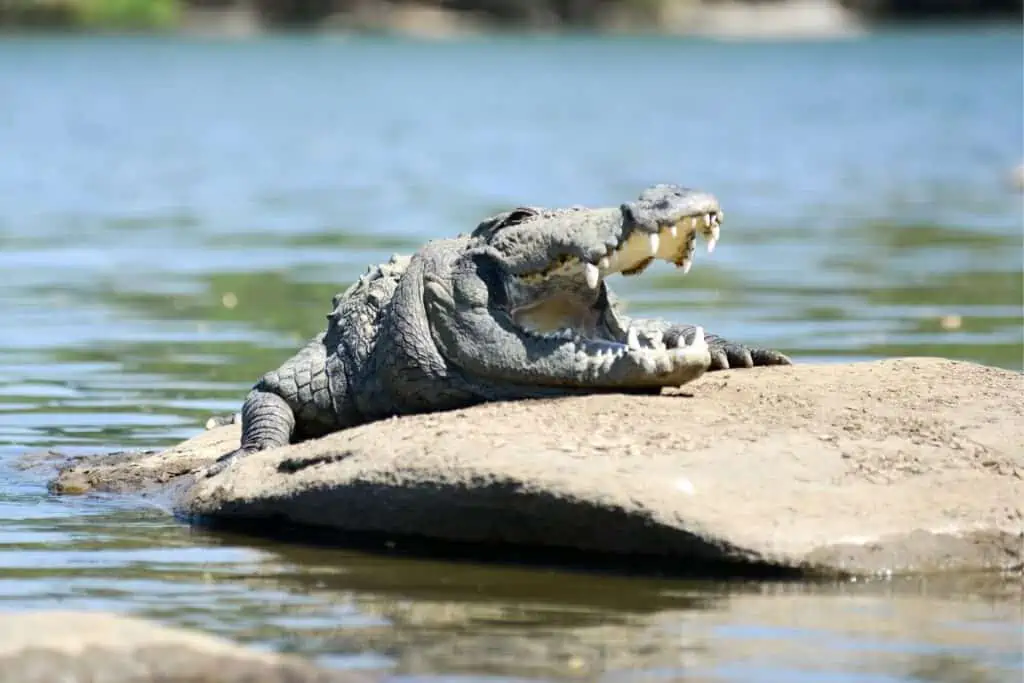
The Average Size Of Crocodiles And Alligators
Another significant point of divergence is the physical size difference between (the largest) crocodiles and alligators.
American alligators grow to over 12 feet. Chinese alligators are smaller, reaching roughly 5 feet.
Crocodiles are diverse, and their average size and weights reflect this diversity. Crocodiles range from the 4.9-feet West African Dwarf crocodile to the enormous 17-feet Saltwater crocodile.
While larger and smaller individuals exist, these are the average size ranges.
The largest alligator on record was around 19 feet, while the largest Saltwater crocodile was 20 feet.
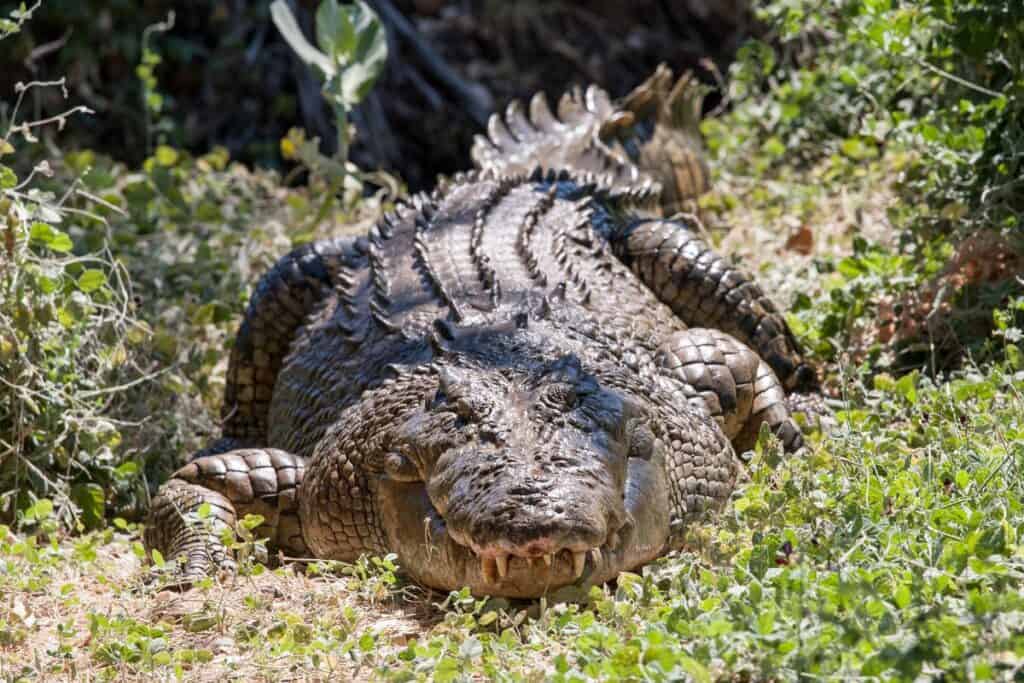
Crocodiles And Alligators Weight Comparison
Alligators and crocodiles vary in weight according to their species.
The West African dwarf crocodile weighs between 40 and 100 pounds. In comparison, Saltwater crocodiles weigh up to a staggering 1 200 pounds (according to Britannica and National Geographics, some Saltwater and Nile crocodiles can reach up to 2 000 pounds).
American alligators are comparable to the largest crocodiles and weigh up to 1 000 pounds, while the smaller Chinese alligator weighs up to 85 pounds (however, most only weigh up to 50 pounds).
Male crocodiles and alligators tend to be larger than females in size and weight.
Crocodile And Alligator Habitat And Distribution
One of the significant differences between crocodiles and alligators is where they live. Crocodiles have a greater distribution than alligators (although there is some overlap between species).
This difference in distribution
is probably related to a physiological characteristic. Crocodiles have salt glands on their tongues which allows them to remove excess salt from their bodies, which means crocodiles are better equipped to live in salt/brackish water bodies.
Alligators lack these glands and prefer (are restricted to) freshwater.
Distribution And Habitat Of Alligators
The two alligator species occur in North America and parts of Asia, respectively. Both species occur in temperate regions.
The American alligator is endemic to the North American continent. They range from Florida in the south, through Southeastern USA, to North Carolina and eastern Texas (the western extent of their range).
Within these areas, American alligators inhabit:
- Coastal wetlands
- The Everglades
- Lakes
- Marshes
- Slow-moving freshwater rivers
- Swamps
Chinese alligators are the only species within the alligator family whose distribution is not in North or South America. The Chinese alligator’s historic distribution included:
- The Yangtze River’s middle to lower reaches
- The Hubei Province, along the river from Shanghai to Jiangling City
The Chinese alligator’s current distribution is limited to the Anhui and Zhejiang provinces in eastern China, in the lower Yangtze River region.
Chinese alligators inhabit slow-moving freshwater lakes, marshes, reservoirs, rice paddies, ponds, and swamps across this distribution.
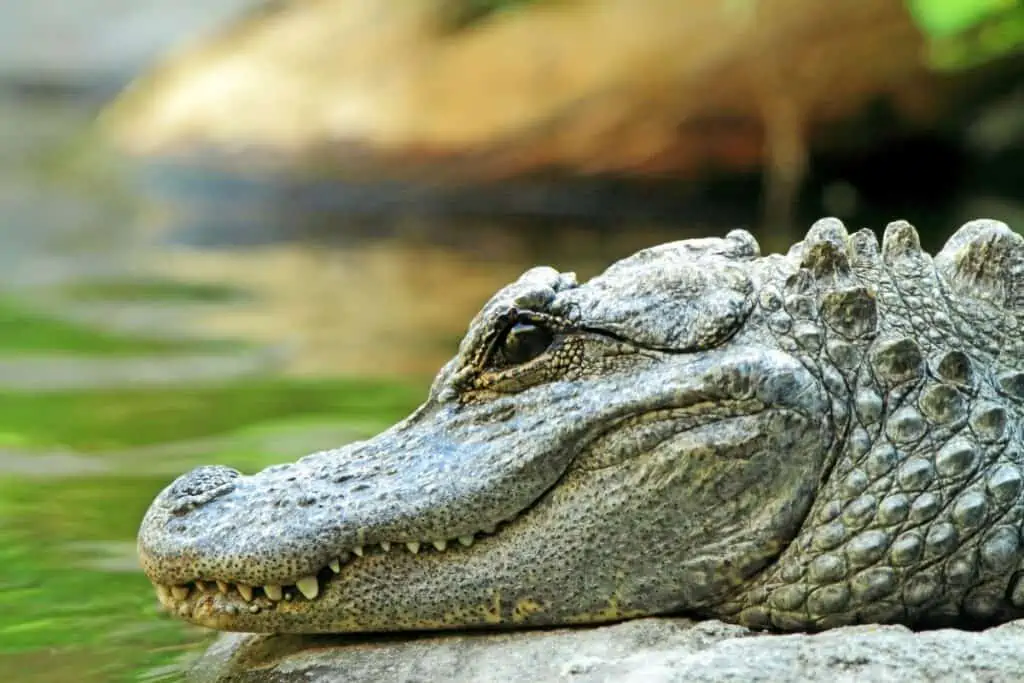
Distribution And Habitat Of Crocodiles
Crocodiles inhabit tropical (and some temperate) regions of Africa, Asia, Oceania, the Americas, and surrounding Islands.
Different species occupy different habitats across their distribution.
Some of these habitats include:
- Coastal regions
- Estuaries
- Lakes
- Lagoons (and Billabongs)
- Marshes
- The ocean
- Pools
- Wetlands
These water bodies are in forests, savannahs, grasslands, deserts, and scrublands. Some species prefer dense vegetation, while others live in open areas. While most crocodiles occupy lowland regions, some species may venture into higher areas (particularly those in forest areas).
The table below briefly compares each crocodile species’ distribution and habitat.
| Crocodile species | Distribution | Habitat |
| African Dwarf crocodile | West to Central Africa. | Forests and surrounding lowlands. |
| African Slender-snouted crocodile | West and central Africa. | Forests and surrounding lowlands. |
| American crocodile | Florida through Central America into northern South America. | Coastal regions, islands, swamps, and mangroves. |
| Australian Freshwater crocodile | Northern regions of Western Australia, Northern Territory, and Queensland. | Freshwater areas (inland waters and rivers), grasslands, and woodlands. |
| Central African Slender-snouted crocodile | Central Africa | Forests, Savannas, and surrounding areas. |
| Congo Dwarf crocodile | Central Africa | Forests and surrounding lowland areas. |
| Cuban crocodile | Central America (Cuba) | Swamps and marshes. |
| Hall’s New Guinea crocodile | Papua New Guinea | Freshwater swamps, rivers, and marshes. |
| Morelet’s crocodile | Central America | Coastal areas (infrequent), lakes, marshes, swamps, and rivers. |
| Mugger crocodile | Indian subcontinent | Freshwater lakes, marshes, pools, and man-made canals/reservoirs. |
| New Guinea crocodile | Papua New Guinea | Freshwater swamps, rivers, and marshes. |
| Nile crocodile | Most of sub-Saharan Africa, along the Nile River to the Mediterranean Sea. | Savannahs, deserts, woodlands, wetlands, grasslands. |
| Orinoco crocodile | Columbia and Venezuela | The Orinoco River basin |
| Philippine crocodile | Dalupiri, Luzon, and Mindanao Islands | Freshwater lakes, ponds, and rivers. |
| Saltwater crocodile | Oceania to Southeast and South Central Asia, including many islands | Coastal, they are often in the ocean, rivers, brackish waters, swamps, wetlands, and mangroves. |
| Siamese crocodile | South China Sea area. | Lowland freshwater regions like lakes, rivers, and swamps. |
| West African crocodile | West to Central Africa | Forests, savannahs, and other lowland regions. |
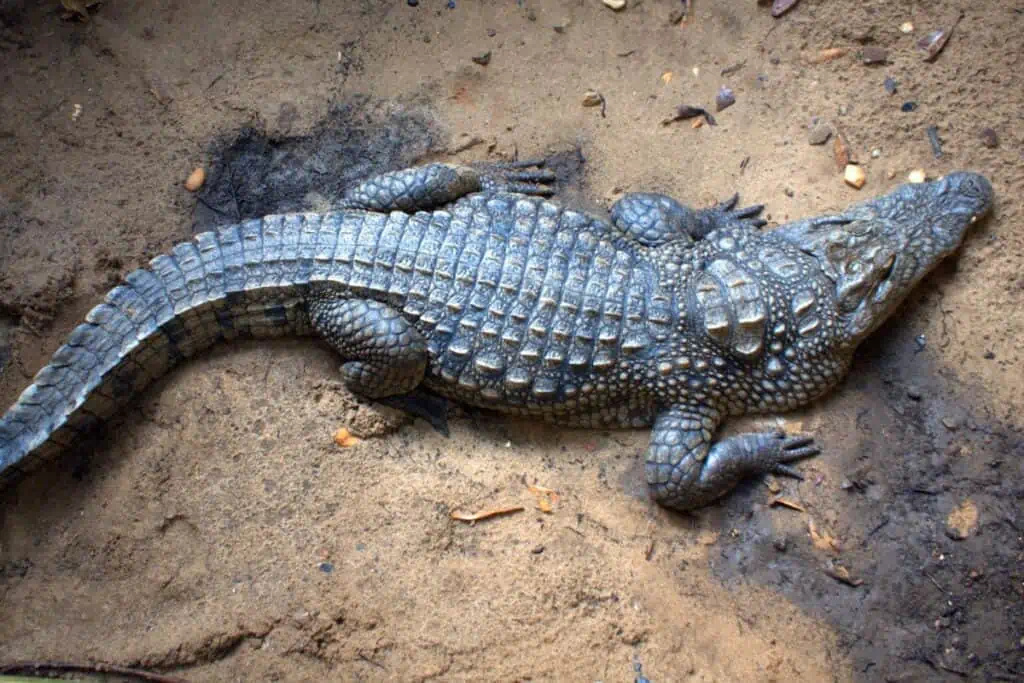
Behavioral Traits Of Crocs And Gators
Behavior is how animals interact with their environment, other species, and individuals of the same species. Sometimes the behavior is related to breeding, sometimes to defense, and other times to feeding.
Although there are some different behaviors between crocodiles and alligators, there are many shared behaviors, including:
- A surprising behavior that crocodiles and alligators share is that many members of each family climb trees. The real surprise is that some observers reported seeing crocodiles up to 32 feet in a tree.
Most of these “arboreal” crocodilians are juveniles who try to sun themselves on high branches or scout the area for threats.
- Crocodiles and alligators bask to warm up and “gape” to cool off. Crocodilians are ectothermic (cold-blooded), which means they don’t regulate their body heat.
Crocodiles and alligators warm themselves in the sun, providing energy for the day. Once they get too hot, they’ll either jump into the cool water or lie on a bank with their mouths open (called gaping) to cool off.
Crocodiles are generally considered more aggressive than alligators, but we don’t recommend trying to pet them either.
Prey And Hunting Techniques
Although there is considerable overlap between crocodiles’ and alligators’ food, feeding habits, and hunting techniques, some differences and variations exist.
A reason for a crocodile’s “V-shaped” head/snout is its diet’s higher fish component. A narrower snout allows quicker underwater movement to snatch fast-moving fish.
Conversely, an alligator’s “U-shaped” broader mouths are stronger than a crocodile’s and are designed to crush “harder” prey items (like turtle shells).
Crocodiles and alligators are carnivores and opportunistic feeders. They are not particularly fussy and eat almost anything they can overpower. Their diets also change as they grow and develop.
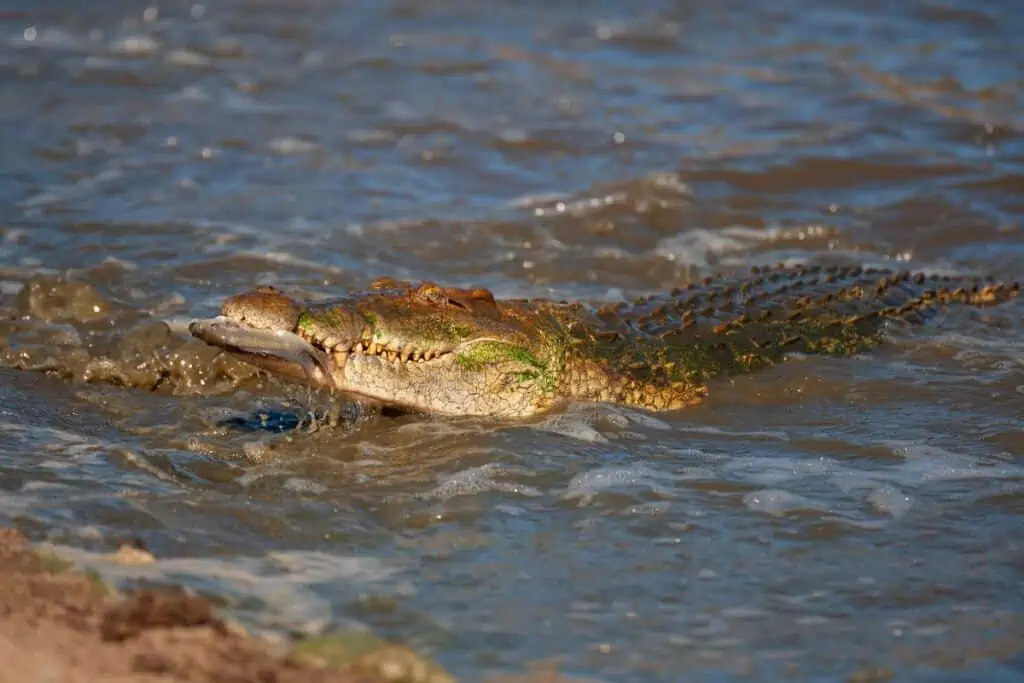
Common Alligator Prey Items
Prey items of Chinese and American alligators include:
- Birds- various waterfowl species
- Invertebrates- various insects, horseshoe crabs, mud crabs, snails, mussels, clams, worms, and crawfish.
- Fish- various species, including stingrays and sharks
- Amphibians- various frogs
- Mammals – Deer, muskrats, raccoons, beavers, feral pigs, black bears, rats/mice
- Reptiles- snakes, smaller alligators, lizards, and turtles
- Carrion
Common Crocodile Prey Items
Various crocodile species eat different prey items. Some include:
- Birds- various waterfowl and other species
- Invertebrates- carbs, mussels, insects, worms, snails, lobsters
- Fish- various
- Amphibians- various (including frogs and salamanders)
- Mammals- antelope, canines (domestic and wild dogs), felines (including lions), livestock, deer, warthogs, monkeys, humans, and rodents
- Reptiles- other crocodiles, snakes, lizards, and tortoises
- Carrion
Hunting Techniques
Crocodilians, across the board, possess an incredible aptitude for hunting. 200 million years of refinement created near-perfect killing machines.
The structure of crocodiles’ and alligators’ heads allows them to see, hear, and smell above water while 90% (or more) of the bodies remain submerged, which assists crocodilians in hunting.
Crocodiles and alligators are ambush predators; however, they adjust their strategies according to the quarry. For land-based prey, crocodiles and alligators stalk and ambush their prey.
As the soon-to-be-meal approaches the water, the crocodilian bursts out, grabs the animal with its powerful jaws and teeth, and drags it back into the water, where the crocodilian drowns the prey.
When catching water-based prey, the crocodilian remains motionless and waits for the fish to approach. Once in range, the crocodilian quickly snatches the swimming creature in its powerful jaws.
Social Structure And Reproduction
Crocodiles and alligators are social animals that form complex hierarchies in their various water bodies.
Little is known regarding the social hierarchies, but researchers from Australia believe that “alpha” crocodiles defend territories with females close by, while subdominant males are forced into areas further away from female congregations.
Although crocodiles and alligators both lay eggs, their nests tend to differ.
Alligators often use surrounding vegetation to create nest mounds. The decomposing plant material keeps the developing eggs warm.
Crocodiles live in warmer regions than alligators, and they usually dig nests in mud or sand along river banks, often along brackish water bodies.
Reproduction frequency and seasonality vary between species; however, alligators and crocodiles usually breed and lay eggs once a year (sometimes as infrequent as every two years).
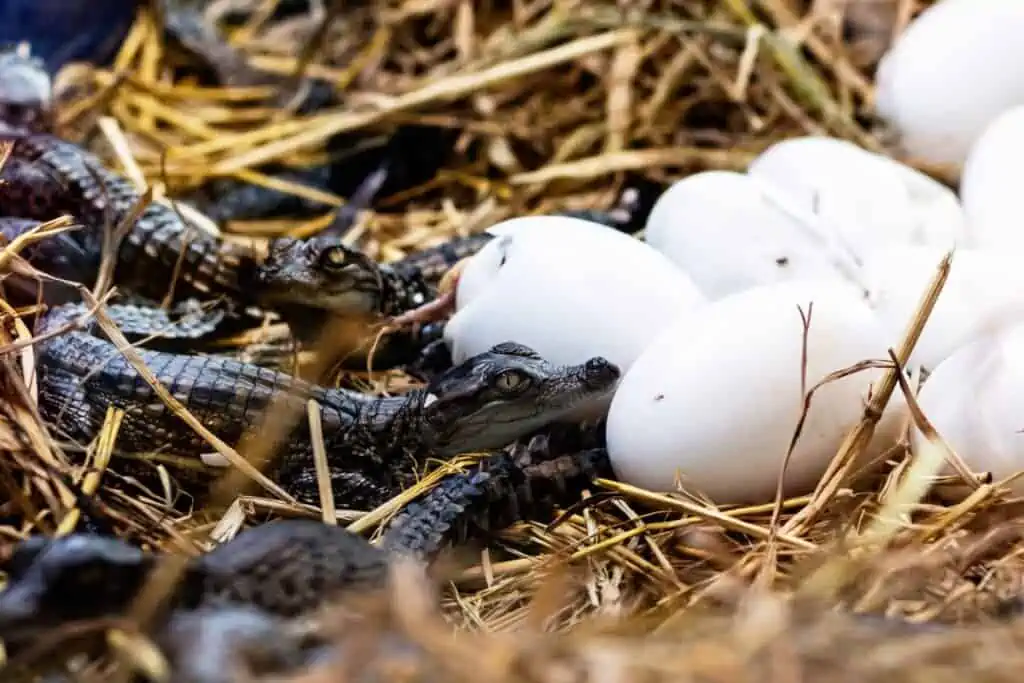
Threats And Conservation
The most significant threats to crocodilians globally are due to humans. Habitat change, habitat destruction, poaching, and pollution are leading causes of declining crocodile and alligator populations.
Crocodiles and alligators often conflict with humans, particularly when the reptile eats livestock or humans.
According to the IUCN, the Orinoco, Philippine, Siamese crocodile, and the Chinese alligator are critically endangered.
Globally, several interventions are designed to protect and preserve crocodiles, and since the 1970s, many populations have stabilized. Providing crocodiles and alligators with CITIES protection and protecting their habitats is critical to conservation efforts.
Which Would Win In An Altercation?
Although a fight between these species is highly unlikely (and we do not condone or encourage anyone trying to instigate one), there is a good chance that the crocodile would come out on top.
However, the outcome depends on the size and weight of the competitors. If you pitted a Saltwater crocodile against an American alligator (both at the top of their weight and size limits), the crocodile would probably be the winner.
If an American alligator faced off against a smaller crocodile, the alligator would probably be victorious.
Final Thoughts On The Differences Between Crocodiles And Alligators
Although crocodiles and alligators belong to the same order and share many similarities, there are several differences.
Crocodiles are usually larger (e.g., Saltwater and Nile crocodiles), their jaws are narrower with protruding teeth when they close their mouths, and they have a wider distribution than alligators.
Both are important for the environment and need human efforts to conserve them, as humans are the greatest threat to their survival.

